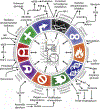Targeting the Warburg effect for cancer treatment: Ketogenic diets for management of glioma
- PMID: 29294371
- PMCID: PMC6927557
- DOI: 10.1016/j.semcancer.2017.12.011
Targeting the Warburg effect for cancer treatment: Ketogenic diets for management of glioma
Abstract
Gliomas are a highly heterogeneous tumor, refractory to treatment and the most frequently diagnosed primary brain tumor. Although the current WHO grading system (2016) demonstrates promise towards identifying novel treatment modalities and better prediction of prognosis over time, to date, existing targeted and mono therapy approaches have failed to elicit a robust impact on disease progression and patient survival. It is possible that tumor heterogeneity as well as specifically targeted agents fail because redundant molecular pathways in the tumor make it refractory to such approaches. Additionally, the underlying metabolic pathology, which is significantly altered during neoplastic transformation and tumor progression, is unaccounted for. With several molecular and metabolic pathways implicated in the carcinogenesis of CNS tumors, including glioma, we postulate that a systemic, broad spectrum approach to produce robust targeting of relevant and multiple molecular and metabolic regulation of growth and survival pathways, critical to the modulation of hallmarks of carcinogenesis, without clinically limiting toxicity, may provide a more sustained impact on clinical outcomes compared to the modalities of treatment evaluated to date. The objective of this review is to examine the emerging hallmark of reprogramming energy metabolism of the tumor cells and the tumor microenvironment during carcinogenesis, and to provide a rationale for exploiting this hallmark and its biological capabilities as a target for secondary chemoprevention and treatment of glioma. This review will primarily focus on interventions to induce ketosis to target the glycolytic phenotype of many cancers, with specific application to secondary chemoprevention of low grade glioma- to halt the progression of lower grade tumors to more aggressive subtypes, as evidenced by reduction in validated intermediate endpoints of disease progression including clinical symptoms.
Keywords: Aerobic glycolysis; Energy metabolism; Gliomas; Glucose; Insulin; Kecondary chemoprevention; Ketogenic diet; Ketosis; Metabolic pathways; Molecular pathways.
Copyright © 2018 Elsevier Ltd. All rights reserved.
Conflict of interest statement
Conflict of interest
There is no conflict of interest.
Figures





References
-
- Cancer: Key Facts. Geneva, Switzerland: : World Health Organization; 2015.
-
- Cancer Facts & Figures. Atlanta, GA : American Cancer Society; 2017.
Publication types
MeSH terms
Substances
Grants and funding
LinkOut - more resources
Full Text Sources
Other Literature Sources

